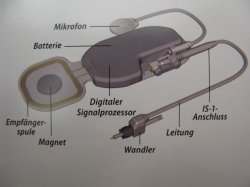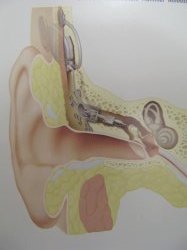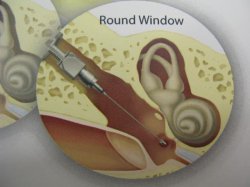Partially Implantable Hearing Aids
It is neither medically, nor surgically feasible to correct hardness of hearing of the inner ear or auditory nerve. Thus, to help someone with this respective subjective impairment, the only option available is to use a hearing aid. For one particular form of hearing impairment, we can offer our patients a special type of implantable hearing aid. This option offers both cosmetic as well as functional key advantages. By fixing a tiny probe in the ear canal, the hearing aid is almost invisibly attached in the ear-fold. When not in use, it can easily be removed. The ear canal stays free, unlike that with conventional hearing aids. Thus, annoying ear pressure effects are eliminated. Frequently, the earplugs required with conventional hearing devices forcefully cause this effect. Moreover, with implantable hearing devices, a largely natural hearing impression can be achieved. The surgery is an outpatient procedure performed under local anesthesia.
Fully Implantable Hearing Aids
Principle and Surgical Technique
A fully implantable hearing device is a hearing aid that is surgically inserted into the middle ear cavity and coupled to the ossicles, replacing the function of the middle ear. A small transducer transmits the sound, received via a microphone, onto the ossicular chain. This causes a vibration that is transmitted to the inner ear, producing the electromechanical coupling. The microphone itself is not visible, being located under the skin behind the ear.
Our preferred fully implantable hearing device is "Carina", from Otologics (www.otologics.com) . This system is fully implantable, as it utilizes an energy source also placed under the skin. The batteries can be recharged via a remote charger through the skin. With precursor products on the market, the energy source was either located on the skin, or was placed under the skin, with a run to the outer connection. On the one hand, this was not entirely satisfactory cosmetically. On the other hand, it was also a potential source for infection.
 |
 |
| Hearing device components |
Schematic illustration of an
implantable hearing device |
During a micro-surgical procedure under general anesthesia, the hearing device components are placed in the middle ear cavity, or respectively, under the skin, through an incision behind the ear. In this process, the transducer is permanently affixed by means of a laser perforation through one of the ossicles. The primary setting and adjustment takes place immediately during the surgery, whereas the actual function does not resume until some weeks later.
 |
Different placements in the middle ear structure |
For whom is a fully implantable hearing device suitable?
In principle, a fully implantable hearing device is also suitable for any patient whose inner ear or middle ear hearing loss can be helped by wearing a conventional hearing aid. The hearing loss is measured pre-operatively and potential hearing gain is determined with a simulation process.
The capacity of fully integrated hearing devices is not unlike that of modern conventional hearing aids. However, the uncomfortable sense of ear pressure caused by the earplugs does not exist with the implantable system. Additionally, there is no danger of infection, unlike the frequently observed local infections of the ears caused by conventional earplugs. Of course, the main advantage over conventional hearing aids is primarily the invisibility and comfort of the device. It is controlled via a transmitter, which can modulate the volume, frequency spectra, and other functions. Individualized programs enable you to quickly switch settings to a changed ambient situation.
Risks and Complications of Hearing Device Implantation
The surgical procedure is low risk - equivalent to that of a simple middle ear surgery (tympanoplasty). The lifetime of the hearing device is that of the battery. The battery in the Otologic system has a 12-year lifetime. After this period, another surgery is necessary, at least to replace the battery. Usually, only the battery requires replacement. Therefore, the second surgical procedure is considerably shorter than the primary surgery.
|